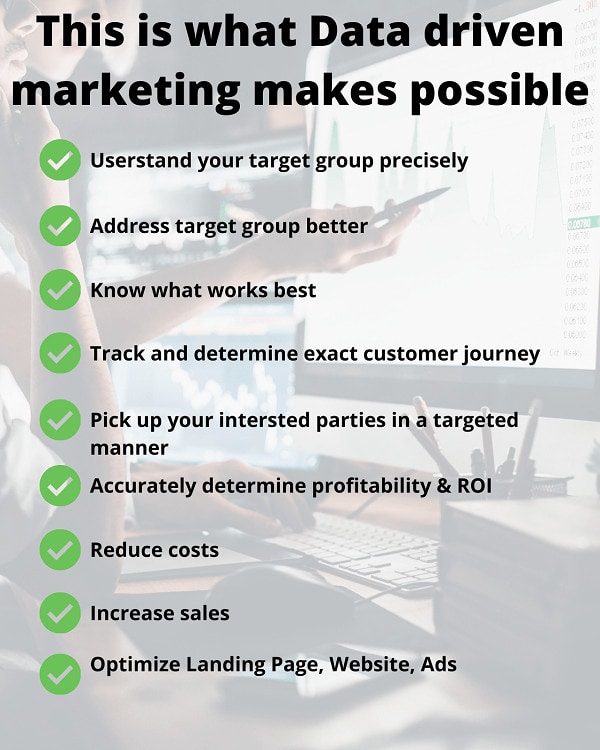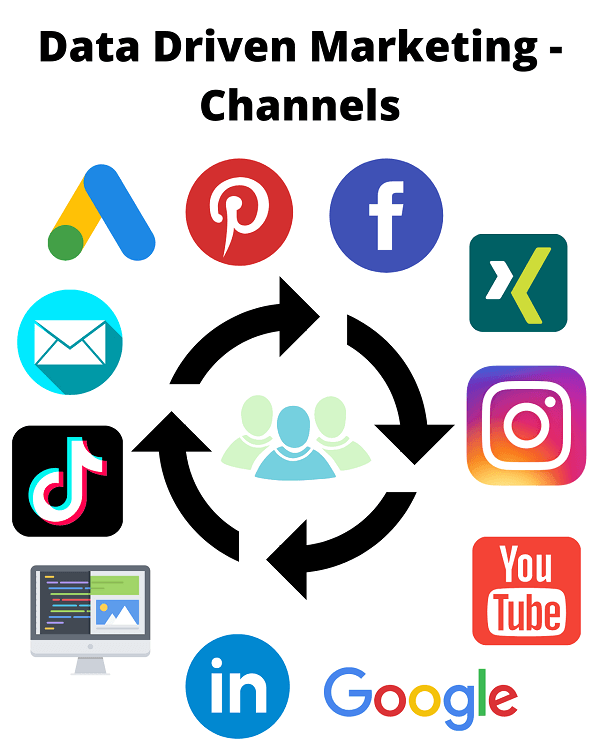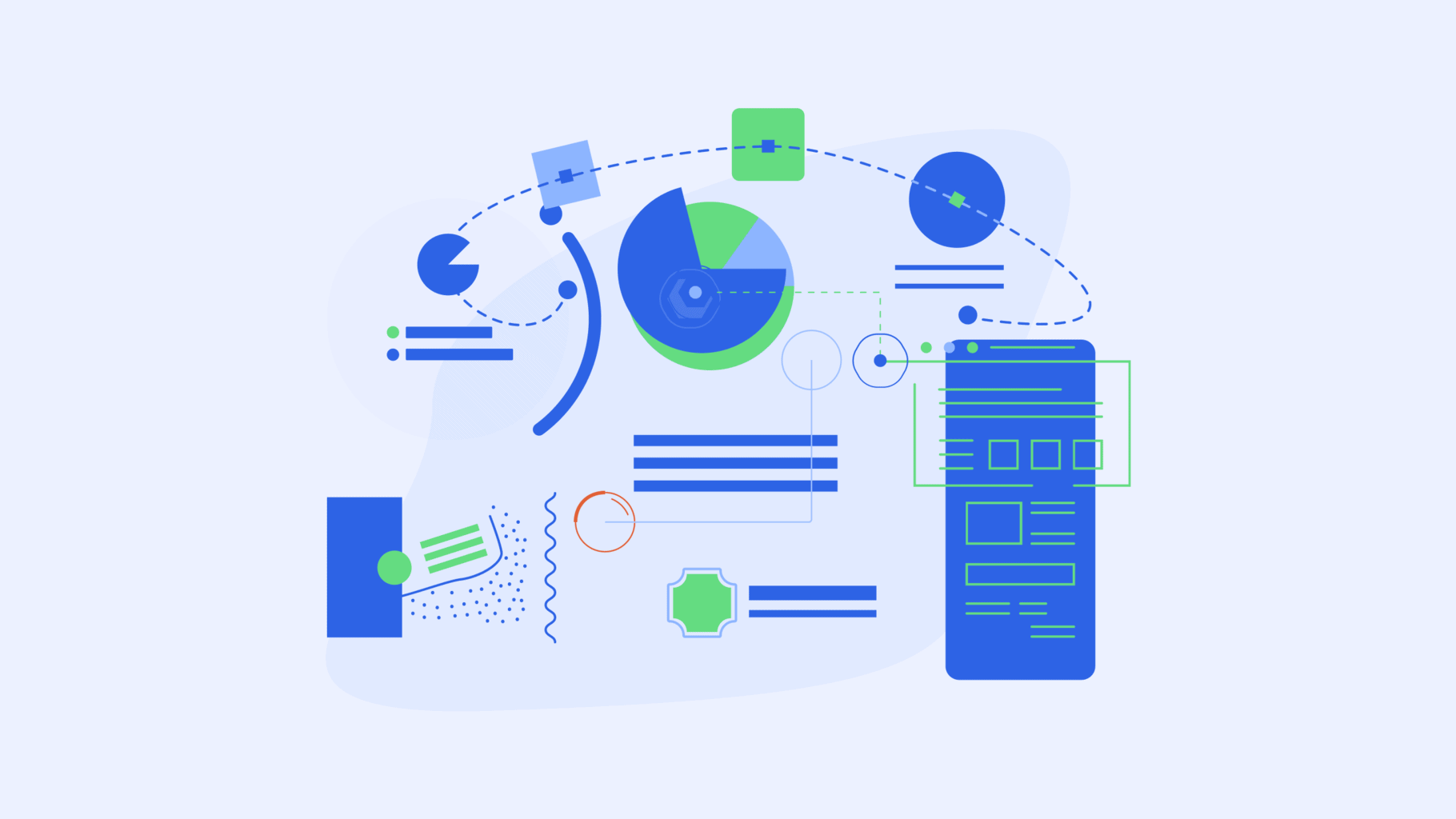Large portals such as Google, Facebook, Instagram, YouTube, Pinterest, TikTok, LinkedIn and XING are free of charge. They do offer additional services, which are then subject to a charge. However, you can use the platforms free of charge.
Because the product is you! All these major platforms and others such as Apple, Amazon and Netflix have mastered one thing above all else: the collection and use of data. The question now is how you can use this data for yourself.
Why is data so important?
Nowadays, we generate an extremely large amount of data. Even a car generates a lot of data (source). The use of various platforms such as Google, Facebook, Amazon, Apple, Netflix, YouTube, Pinterest and other well-known social networks generates even more data.
Those who master data collection and utilisation are particularly good at one thing: understanding their customers better, making them better offers and responding much more precisely to their needs.
So for us, the advertisers, data is also extremely important. Data can make the difference between a profitable and a highly profitable campaign. As an online marketer, you use data to know exactly what specific customers prefer in a specific area, how people react to certain things and what they particularly like.
The special thing about digital marketing is that every visit to the website, every enquiry and every purchase can be tracked precisely and used for further marketing. The highlight: every participant on the internet, including you, usually already has a lot of data that could be utilised.
Content marketing for advanced users: The 6 most important levers
Discover how to optimize your content marketing to reach the right audience, build trust, and achieve long-term success.
What is data-driven marketing?
Data is important because it can be used to achieve different goals particularly efficiently. There are different variants and levels of detail in the meaning and definition of data-driven marketing. Basically, data-driven marketing means that data is collected. This data is used to gain a much better understanding of the needs of potential customers (usually your own target group). Once this is understood, these people can be addressed immediately or more easily and effectively in a second step.
The data can come from different areas. It can be structured or unstructured. All of this is summarised under the now familiar technical term “big data“.

However, big data is mostly used in larger companies such as Amazon, Google and Netflix. Most smaller companies then use the “finished product” in which the data has already been organised, filtered and structured.
Using data-driven marketing, it is possible to predict the future behaviour of interested parties from the numerous data, interactions and engagements, purchasing behaviour and other information, or at least to interpret it much better.
When collecting data, it is important not only to collect the data, but also to analyse and structure it correctly. Only if the data is properly structured and organised can it be read and interpreted much more easily. Each scenario may require different data.
Where can data be collected?
If data is to be collected for your own marketing use, there are numerous ways to do this. The options for data collection can vary depending on the size of the company.
Regardless of whether this is limited or almost unlimited, either way a goal must be defined for which the data is required. This will simplify the data collection, structure and possibilities. Once the goal has been defined – and it is therefore clear what the data is needed for – the next step is to define the channels for data collection.

Buyer Persona
But before this can happen, the buyer persona should be created. Buyer personas are the image of ideal customers, also known as customer avatars.
A buyer persona contains the following components, among others:
- Age
- Gender
- Education
- Family status
- Income
- Difficulties
- Needs
- Wishes
- Speech
It is advisable to create such a customer avatar in great detail and also give this person a name including a picture. The more detailed your research is, the easier it will be for you to address your ideal customers – regardless of the platform.
In the following chapters, we will look at various channels and what data actually means for these channels in practice.
Data in search engine optimisation (SEO)
Search engine optimisation is very important these days. In this country, this is usually only understood to mean optimisation for Google, but SEO is more far-reaching. Nevertheless, here too we are focussing on the Google search engine.
What is SEO?
At SEO, attempts are made to optimize your own website so that it ranks in the top of the desired search terms in order to attract more visitors organically. They should then subscribe to the newsletter, book an appointment or buy something directly. So the goals are different.
If someone lands on the website and navigates to other subpages, this – and much more – can be tracked. First, of course, the website must be optimised so that visitors can find the website in the search engine and access it.
There are really many ranking factors for this. To name just a few aspects:
- General functioning of the website, broken areas and links
- Loading speed of the website (PageSpeed), this should be as low as possible
- Ease of use and user experience (e.g. navigation)
- Quality of the text
- Number of links incl. link text
By using SEO tools, you can find out whether and where the website still needs to be optimised. You can find out what your competitors’ websites look like, which links they have from which websites and much more.
Using SEO tools can provide a lot of clarity and save a lot of (wrong) work. It is also important to analyse the behaviour of users on the website. If the website has now been optimised – and numerous users are coming to the site – it is good to know how they behave on the site.
Different tracking tools such as Google Analytics, Matomo and others can reveal a lot about the individual user and the target group.
Among other things, you find out the following:
- Origin/location/region (country)
- Resolution
- Operating system and device used
- Visited page(s) incl. actions
- Total time spent on the website
- At which page the website was left again
If you also use a heatmap tool, you can analyse the scrolling behaviour of users. This means that you then know how far users scroll down the page, where they click and a lot more valuable information. This information can be used to make further optimisations.
I was able to optimise one of my landing pages using the heatmap because users clicked on a field where there was no button, but they probably thought there was. I then made this area clickable and thus significantly increased my conversion.
Search Engine Advertising (SEA) and data
What is SEA?
Data is extremely important for the big topic of search engine advertising. SEA is concerned with various search terms that are used for the advertisement so that the target group searches for it and sees the advertisement.
Based on these search terms, various campaigns with different content formats as well as headlines or descriptions can be created. This can even be expanded and provided with suitable images or supported with corresponding videos.
The exciting part, however, is that it is possible to address different users due to the different design of the adverts. A split test can be used to find out which target group, or which part of it, reacts how well to which type and variant of the advert.
In a split test, only a single component should be changed and then tested. This helps to make the advert even better and more lucrative. The keyword may be the same, but the headline, description and possibly even the image may be different.
However, not only the advert, but also the landing page can be tested. This enables you to create the best possible combination of advert and landing page to best appeal to your visitors.
There are so many possibilities and combinations that can be tested that not everything can be listed in this article. What you should definitely take with you is that you should definitely carry out numerous tests in order to address your target group even better. This can significantly increase profitability.
Managed WordPress Hosting
With our Managed WordPress hosting, you get a powerful, secure and easy-to-manage solution that quickly and reliably takes your WordPress project to the next level. Check it out!
You can also split the target group and create age groups. For example 24 – 34, 35 – 44, 45 – 54, etc. Then test them against each other. You can do the same with married, single, divorced, single. Interests, educational qualifications and a few other things.

This also allows you to split your adverts and address your target group even more precisely. This allows you to see which group of people responds best to which ad and offer so that you can optimise them further.
In a nutshell: By addressing the person again, you can respond to them in an even more targeted manner. This ensures that the price for a new enquiry (lead) or for new customers can be reduced – sometimes even very significantly!
Paid advertising on Facebook & Instagram
Data is particularly important on social networks and therefore also on Facebook and Instagram. The reason is quite simple: people who use social media can be addressed much better as they reveal their interests and a lot more about themselves.
The right target group research, including interests and the corresponding images, videos, texts, headlines and the language of the customers can make the difference between the success and failure of a campaign. Of course, the corresponding landing page must also be suitable and reflect the message and words from the advert.
The more precise the target group research, the tests, including analyses and evaluations, the better the results of the respective marketing campaign will be. This effort will be reflected in the price per lead and therefore also in the costs per customer acquired.
However, it is important that every single step in the process can be tracked so that it is possible to trace exactly when a person clicked on the link, reached the landing page and signed up.
All this information is very important for remarketing and target group expansion(Custom Audience and Lookalike Audience). Based on this data, the following is now possible:
- Tell the Facebook algorithm that you want more of these people to click on your website and visit the landing page.
- Tell the Facebook algorithm that you would like to have more of those people who are more willing to book an appointment with you.
The same can be done if you want to reach more people who have interacted with your profile or page. If you use a video for your advert, you can retarget those who have watched 90% of the video, for example.
As you can see, you can use the data to find out more about your target group and customers and show them even more relevant offers. We work in exactly the same way at our agency, DIVA Consulting, to achieve results as quickly as possible and, in particular, with high quality, at the most favourable lead and customer price possible. What makes us special: We guarantee results, otherwise the service is free of charge.
Is the high cost justified?
Even if that wasn’t all, it may sound like a lot of effort and whether this is justified at all. You could simply get started and select the interests of the supposedly known target group for the campaign.
Of course, the effort is relatively high, but only relatively. Because everything always has to be put into perspective. If you just go for it, you can quickly end up burning a lot of money – which can easily happen in the pay-per-click (PPC) sector.
For this reason, we believe that this effort is definitely justified. The special thing about data is that it is simply brutally honest. A click through rate (CTR) of 3 % and a conversion rate of 10 % are exactly what they are. This data helps you to find out how much money you need to invest in adverts in order to get a return on investment (ROI) of X.
A sample calculation
I would like to use an example to demonstrate the profitability and justification of the effort involved:
- 100,000 impressions with a CPM (cost per mille / cost per 1,000 impressions) = €25 => €2,500 advertising budget
- Of which 1 % CTR = 1,000 people click on your website
- Of these, 5 % (= 50 people) register for an interview
- The completion rate in the dialogue is 20% and therefore 10 new customers
- Customer value = 2500 euros, so 25,000 euros in sales were generated and 2,500 euros in costs. This corresponds to an ROI of 10 and leaves 22,500 euros after deducting advertising costs.
If we now optimise the display and apply the following results:
- 100,000 impressions with a CPM (cost per mille / cost per 1,000 impressions) = €25 => €2,500 advertising budget
- Of which 3 % CTR = 3,000 people click on your website
- Of these, 15 % (= 450 people) register for an interview
- The completion rate remains at 20 %, meaning that 45 new customers were acquired
- Customer value = 2,500 euros, so 112,500 euros in sales were generated, offset by 2,500 euros in costs. This corresponds to an ROI of 45, leaving 109,000 euros after deducting advertising costs.
This means that in this example, 87,500 euros more revenue was generated even though the other parameters remained the same. Only the landing page and advert incl. text, image/video contributed to the better results. If the budget were higher, higher sales could presumably be recognised.
The same applies to a better completion rate. Even if this example was created on a “greenfield site”, the figures show what prior analysis and optimisation can achieve. You are therefore welcome to answer the question yourself as to whether this effort pays off.
Which tools to use for data-driven marketing?
As a rule, the respective platforms already offer good tools. For SEO, you can use Google Analytics in addition to Google Search Console (or alternatively: matomo). Other good SEO tools are Searchmetrics, Ryte and Sistrix.
Borlabs Cookie: The most popular cookie plugin for WordPress
Although the DSGVO came into force in 2018, many WordPress users are still struggling to implement the requirements. But there are very useful plugins like Borlabs Cookie that support us in implementing the DSGVO and E-Privacy regulation.
For small sites and beginners, there are also free SEO tools that can be considered for the first steps. Google Data Studio, Google Analytics and Google’s Keyword Planner are very suitable for paid adverts in the search engine (SEA).
For Facebook and Instagram Ads, you can also use the Target Group Insights and the Facebook Ad Library. These are good starting points for research and inspiration. Regardless of which platform you use, the tracking pixel and code must always be installed so that all actions are tracked accordingly and data is collected.
Conclusion: Efficient online marketing is not possible without good data
After all this information, it should now be clear that efficient online marketing is no longer possible without decent data. Paid adverts are becoming more expensive, people are increasingly immune to adverts and know that they are adverts.
For this reason, it is impossible today to do without data and not utilise it. Of course, this can go much further with big data – but it would be going too far at this point. Big data could then be used to take other information into account, such as hormonal changes in weather patterns, weekend or public holiday activity, etc. Here’s my film tip for you: Cambridge Analytica.
The fact is that data is incredibly important and should definitely be used if you want to reach your target group and place lucrative adverts. However, you should also keep data protection in mind and collect the data and analyse it extensively and in the right way in accordance with the GDPR. If you don’t do this, you are missing out on untapped potential.
As I said, the data collection, analysis and use could certainly go much further, as shown in the Cambridge Analytica film, but many are already not using the possibilities presented in this article. Is it ignorance, fear or laziness? Probably a good idea for a survey. What do you think?
Your questions about data driven marketing
If you have any further questions about data driven marketing, please use the comment function. Would you like to receive tips on online business, web design and WordPress in the future? Then follow us on Facebook or via our newsletter.

Leave a Reply